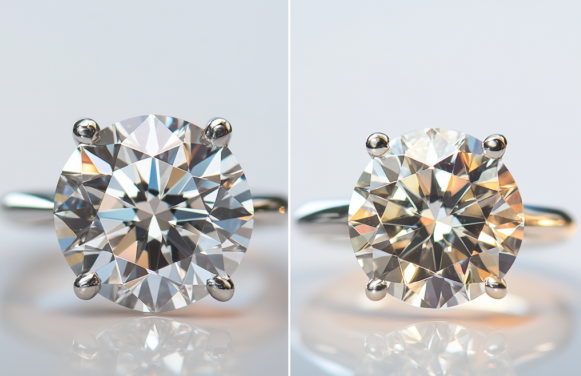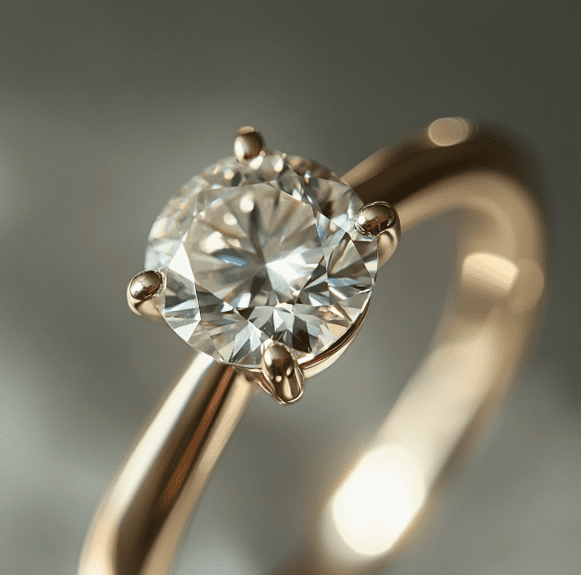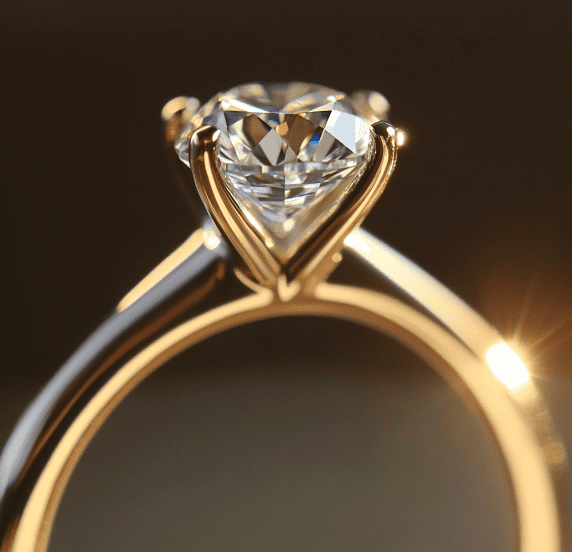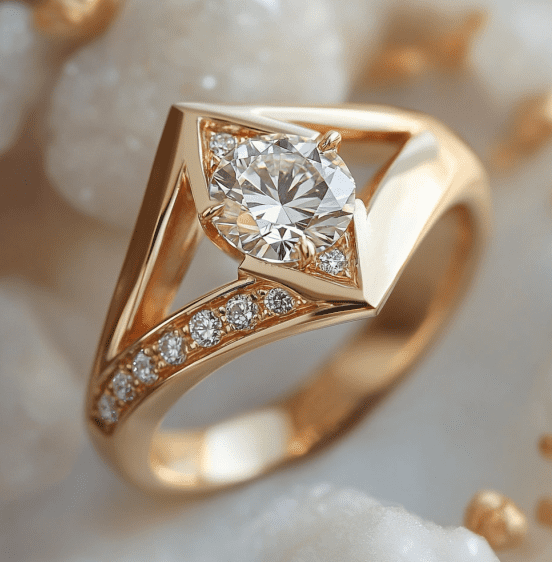Diamond Ring
The Ultimate Guide to Choosing, Caring for, and Valuing this Timeless Jewel
Diamond Ring: How Carats Affect Its Value?
When it comes to a diamond ring, one of the most crucial factors determining its value is the carat weight of the diamond. While carats are only one of the four key criteria used to evaluate diamonds (along with colour, clarity, and cut), their impact on the stone’s price and overall appeal is significant. But how exactly do carats influence the value of a diamond ring? Below, we explore the meaning of carats, their relation to size, and their role in determining a diamond’s value.
- What Are Carats in a Diamond Ring?
Carats are the unit of measurement used to determine a diamond’s weight. One carat is equivalent to 200 milligrams, and each carat is divided into 100 points. This means a 0.5-carat diamond, for example, weighs 100 milligrams or 50 points.
It’s essential to understand that carats refer exclusively to the diamond’s weight and not necessarily to its size. A 1-carat diamond ring doesn’t always look twice as large as a 0.5-carat ring, as other factors like cut also influence the perception of size.
- The Effect of Carats on Diamond Size
While carat weight and diamond size aren’t the same, there is a correlation. As carat weight increases, so does the diamond’s visible size. However, the size increase isn’t proportional. A 2-carat diamond won’t be exactly twice as large as a 1-carat diamond, but it will be noticeably larger.
This is important because the diamond’s size influences its appearance and how it looks on the ring. A diamond ring with a larger stone tends to have more presence and attract more attention, which can make it more desirable for some people.
- The Relationship Between Carats and Price
One of the most important aspects of carats is how they affect the price of a diamond ring. The price of diamonds doesn’t increase linearly with carat weight; in fact, the price per carat rises significantly as the diamond’s weight increases. This is because larger diamonds are much rarer than smaller ones, making them a more exclusive and therefore pricier choice.
For example, a 1-carat diamond won’t simply cost twice as much as a 0.5-carat diamond. It may cost three or even four times more due to its rarity and higher demand. This price increase is also influenced by other factors such as colour, clarity, and cut, but carat weight is one of the primary drivers of value.
- Do More Carats Mean Greater Value?
Generally, yes, a higher carat weight translates into a higher value for the diamond ring. However, this doesn’t mean that choosing the largest diamond is always the best option. Other factors, like the quality of the cut, colour, and clarity, also significantly influence the diamond’s appeal and quality.
A larger diamond with low clarity or a poor cut may not be as beautiful as a smaller diamond of excellent quality. The balance between carats and the other three criteria is essential to ensure that you’re getting a diamond ring that not only holds great value but is also visually stunning.

- Carats and Personal Choice
The number of carats you should choose for your diamond ring also depends on personal preference and lifestyle. Some people prefer a larger, more eye-catching diamond, while others opt for a smaller stone of higher quality. Additionally, the size of the wearer’s finger can influence the choice of diamond size.
A ring with a 1-carat stone may look larger on a small hand and more understated on a larger hand. Therefore, it’s essential to consider how the ring will appear on the person who will wear it, along with the carat weight.
- Tips for Choosing the Best Carat Weight
When selecting a diamond ring, it’s crucial to find a balance between carats, quality, and budget. Here are some tips to help make an informed decision:
- If you’re looking to maximise the visual size of the diamond without significantly increasing the budget, consider choosing a carat weight just below whole numbers, such as 0.9 carats instead of 1 carat. These diamonds are often more affordable, with a nearly imperceptible size difference to the naked eye.
- Focus on the quality of the cut. A well-cut diamond can make a smaller stone appear larger and more brilliant than a heavier diamond with a poor cut.
- If you prefer a ring that balances presence and quality, a diamond between 0.5 and 1.5 carats may be ideal to achieve the right balance of size, quality, and price.
Conclusion
Carat weight is a crucial factor in the value and appearance of a diamond ring, but it’s not the only criterion to consider. When weighing the size, price, and quality of a diamond, it’s essential to find the right balance that suits your personal preferences and budget. Choosing a higher carat weight can add prestige and presence, but other factors like cut, colour, and clarity also play a vital role in the ring’s beauty.
The Diamond Ring Certification Process: What You Need to Know?
When purchasing a diamond ring, one of the most important aspects to consider is the certification of the gemstone. Certification is a process that guarantees the authenticity and quality of the diamond you are acquiring. Without proper certification, it can be challenging to accurately determine the characteristics and value of a diamond. In this article, we’ll explain the diamond ring certification process in detail and why it’s crucial for ensuring a safe and reliable purchase.
- What is Diamond Ring Certification?
Diamond ring certification is a report issued by an independent gemological laboratory that assesses the gemstone’s characteristics. This report, known as a “diamond certificate” or “gemological report,” details the essential characteristics of the diamond, including the 4Cs: cut, colour, clarity, and carat weight.
It’s important to note that certification is not the same as an appraisal or a warranty. While an appraisal establishes the monetary value of the ring, certification provides a technical and objective description of the diamond. This ensures that the buyer has a reliable reference for the quality of the stone.
- Leading Certification Laboratories
Not all diamond certificates are the same, as they vary depending on the issuing laboratory. Several globally recognised gemological laboratories specialise in diamond certification. Some of the most respected include:
- GIA (Gemological Institute of America): One of the most prestigious and trusted laboratories for diamond certification, known for its strict objectivity and accuracy in assessing the 4Cs.
- HRD Antwerp (Hoge Raad voor Diamant): Based in Belgium, this is one of Europe’s leading laboratories, recognised for its high standards in diamond certification.
- IGI (International Gemological Institute): Another reputable laboratory offering detailed gemological reports. Although some experts believe IGI’s standards may be slightly less stringent than GIA’s, it is still widely respected.
- AGS (American Gem Society): Known for its focus on cut quality, AGS provides a detailed grading of a diamond’s light performance and brilliance.
Before buying a diamond ring, it is essential to ensure the diamond has been certified by one of these prestigious laboratories, as this provides greater confidence in the stone’s quality and authenticity.

- What Information Does a Diamond Certificate Provide?
A diamond ring certificate details several important characteristics of the stone, allowing you to understand its quality and authenticity. The main features evaluated in the certificate include:
- Cut: The certificate describes the quality of the diamond’s cut, a crucial factor in determining its brilliance and beauty. A good cut allows light to reflect optimally through the stone, while a poor cut can make the diamond appear dull.
- Colour: Diamonds are graded on a colour scale from D (completely colourless) to Z (light yellow or brown). A certificate will indicate the diamond’s colour grade, which affects its value.
- Clarity: Clarity refers to the presence of internal and external inclusions or imperfections in the diamond. The certificate provides a clarity rating, ranging from “FL” (flawless) to “I” (inclusions visible to the naked eye).
- Carats: The diamond’s weight in carats is also detailed in the certificate. The more carats the diamond has, the higher its value, although factors like cut and clarity also play a role.
In addition to the 4Cs, some certificates may include information about the stone’s exact proportions, symmetry, polish, and whether it has been treated to enhance its appearance.
- The Importance of Certification for Diamond Ring Value
Having a certified diamond ring not only provides peace of mind to the buyer but also directly impacts the jewellery’s value. Certified diamonds are much easier to appraise and resell, as buyers and appraisers can rely on the data provided by the laboratory.
If you wish to sell or trade your ring in the future, the certificate will serve as proof of authenticity and quality. Furthermore, rings with certified diamonds tend to have a higher resale value, as potential buyers can verify the stone’s characteristics without needing a new evaluation.
- How to Verify a Diamond Certificate
Once you purchase a certified diamond ring, it’s important to verify the certificate’s authenticity. Gemological laboratories like GIA or IGI offer online databases where you can enter your diamond’s certificate number to confirm its authenticity. This ensures that the diamond matches the characteristics described in the certificate.
It’s also advisable to work with reputable jewellers who provide certificates from recognised laboratories. Avoid buying diamonds from sellers who don’t provide proper documentation, as this may indicate that the stone is not genuine or lacks the promised quality.
- Conclusion
The diamond ring certification process is essential for ensuring you’re acquiring an authentic, high-quality piece. A gemological certificate provides an objective assessment of the diamond’s characteristics, helping to determine its value and giving you confidence in making a sound investment. When purchasing a diamond ring, ensure that the stone is certified by a reputable laboratory and review the information on the certificate carefully. This will allow you to enjoy the beauty of your ring with complete peace of mind, knowing that you have acquired a guaranteed quality piece.
Meaning and Symbolism Behind the Diamond Engagement Ring
The diamond ring is one of the most powerful and recognised symbols of commitment and eternal love. Its history and symbolism are deeply rooted in various cultures and traditions, making it the preferred choice for sealing a marriage promise. However, its significance goes beyond being a beautiful piece of jewellery; the diamond ring embodies values like purity, strength, and eternity, reflecting the foundations of a lasting relationship. In this article, we explore the meaning and symbolism of the diamond engagement ring and why it remains an icon of love.
- Symbolism of Diamonds: Strength and Durability
Known as the hardest natural substance on Earth, the diamond has long been associated with strength and durability. These attributes make it particularly suited to represent a commitment, symbolising the solidity and permanence of the relationship. The diamond ring conveys the idea that the love between two people is unbreakable, able to withstand the test of time and challenges.
Additionally, the word “diamond” derives from the Greek “adamas,” meaning “invincible” or “unbreakable.” This term reinforces the symbolism of an unbreakable commitment, making the diamond ring a visual representation of a promise meant to last forever.
- The Circle as a Symbol of Eternity
Not only does the diamond carry a deep meaning in the engagement ring, but so does the ring’s circular shape. Rings, as continuous circles, have symbolised eternity for centuries, with no beginning or end. This unbroken circle represents eternal love and unity between two people who are committed to each other forever.
The diamond ring combines two powerful symbols: the strength and durability of the diamond and the infinite concept represented by the circle. Together, they symbolise a love that is strong, eternal, and unbreakable.
- The Diamond Ring as a Token of Love and Devotion
Historically, the diamond ring has been a symbol of devotion and a testament of love. In the 15th century, Archduke Maximilian of Austria became the first recorded person to give a diamond engagement ring to his fiancée, Mary of Burgundy. This gesture marked the beginning of a tradition that continues to this day.
Over time, the diamond ring has become an emblem of serious commitment and a tangible proof that a person is willing to dedicate their life to another. The gemstone and the ring-giving ceremony reflect the intention of the person proposing marriage: to create a relationship founded on unwavering love and loyalty.
- Purity and Clarity: Values Reflected in the Diamond
One of the most notable features of diamonds is their clarity. A high-quality diamond is nearly colourless and transparent, symbolising the purity of love in a commitment. This purity doesn’t only refer to the physical beauty of the stone but also to the intention and sincerity of the commitment.
By giving a diamond ring, the message conveyed is that the relationship is pure, honest, and unconditional. The diamond’s clarity can reflect transparency in communication and trust between the two committed individuals, essential values in a lasting relationship.

5. The Diamond’s Brilliance: A Reflection of Love’s Light
The unmatched sparkle of a diamond, known as its “fire,” symbolises the spark and vitality that true love brings into one’s life. A diamond ring captures and reflects light, creating a glimmer that represents the energy and passion within a relationship. This brilliance is a metaphor for how love can illuminate a couple’s lives, bringing joy and hope for their future together.
The diamond’s sparkle is also associated with the idea that love should be visible and celebrated. Wearing a diamond ring allows individuals to show the world their commitment and pride in their relationship, letting their love shine brightly.
6. A Global Symbol of Love and Tradition
Over the centuries, the diamond ring has transcended cultural boundaries to become a universal symbol of love and commitment. While traditions may differ across countries and religions, the act of giving a ring to propose marriage is a shared ritual in many parts of the world.
In some cultures, the diamond ring represents more than just a piece of jewellery; it signifies the spiritual and emotional bond between two people destined to spend their lives together. The use of a diamond in engagement rings is not merely a modern trend but a tradition rooted deeply in the symbolism and reverence for eternal love.
The diamond ring is more than a beautiful piece of jewellery; it is a powerful symbol of love, commitment, and eternity. From ancient times to the present, diamonds have represented strength, purity, and devotion in relationships. The combination of a diamond’s brilliance with the meaning of the unbroken circle creates a visual representation of an eternal bond. Choosing a diamond ring to seal a promise of love is to embrace a rich tradition of symbolism that continues to resonate today, reinforcing the values of loyalty, durability, and pure love.
Different Types of Cuts in a Diamond Ring: Which Best Enhances Its Beauty?
A diamond ring is one of the most coveted and elegant pieces of jewellery available. However, not all diamonds are the same, and one of the most crucial aspects defining a diamond’s beauty and brilliance is its cut. The cut doesn’t just refer to the diamond’s shape but also to how its surfaces have been crafted and faceted to maximise the light it reflects. In this article, we’ll explore different types of cuts in a diamond ring and how each one enhances the stone’s unique beauty.
1. Round Brilliant Cut: The Classic Favourite
The round brilliant cut is, by far, the most popular and classic choice for diamond rings. It’s estimated that around 75% of all diamonds sold have this cut. Its design includes 58 perfectly aligned facets that maximise the diamond’s sparkle and fire, allowing light to enter and exit the stone in an optimal way.
The round brilliant cut is ideal for those looking for a ring that catches light from all angles, shining brilliantly in any setting. Its symmetrical shape and light-reflecting ability make the diamond appear larger and more radiant than other cuts.
2. Emerald Cut: Sophisticated Elegance
The emerald cut is characterised by its rectangular shape with step-like facets, creating a unique and elegant visual effect. Unlike the round cut, which maximises sparkle, the emerald cut highlights the diamond’s clarity, giving it a more refined and sophisticated look.
This cut is perfect for a diamond ring that aims to project class and understated style. Since it isn’t as sparkly as the round cut, it’s essential to choose a high-quality diamond, as any imperfections in clarity will be more noticeable.
3. Princess Cut: Modern and Brilliant
The princess cut is a favourite among those looking for a modern yet equally brilliant diamond ring. This square or rectangular cut features a facet arrangement that maximises sparkle, similar to the round cut but with a more geometric aesthetic.
The princess cut is ideal for those seeking a contemporary style without sacrificing brightness. Additionally, thanks to its design, this cut can make a diamond appear larger, making it an excellent choice for those seeking a significant visual impact without considerably increasing the budget.

4. Oval Cut: Elongation and Elegance
The oval cut is a variation of the round brilliant cut but with an elongated shape that adds a touch of distinction. This cut is ideal for those who want something different from the round cut but still value the diamond’s sparkle and light reflection.
One benefit of the oval cut is that its elongated shape can create the illusion of a larger diamond. Additionally, its form tends to lengthen the look of the wearer’s fingers, adding a touch of elegance and sophistication.
5. Pear Cut: A Romantic Touch
The pear cut, also known as the teardrop cut, combines the sparkle of the round cut with the elegance of the oval cut. The diamond features a sharp point at one end and a soft curve at the other, giving it a unique and romantic appearance.
This cut is an excellent choice for those looking for a diamond ring that blends classic and modern. Like the oval cut, the pear’s elongated shape can make the diamond appear larger and give a graceful look to the wearer’s fingers. It’s ideal for those with an elegant and delicate style.
6. Cushion Cut: A Blend of Classic and Modern
The cushion cut, also known as the pillow cut, has gained popularity in recent years due to its blend of vintage and modern styles. It has a square or rectangular shape with rounded corners, giving it a soft, romantic look.
This cut is known for its impressive sparkle and light dispersion, giving the diamond a warm glow. A cushion-cut diamond ring is an excellent choice for those wanting a timeless piece with a nostalgic touch.
7. Radiant Cut: Modern and Striking
The radiant cut combines the best features of several cuts, including the clipped corners of the emerald cut and the sparkle of the round brilliant. It is a square or rectangular cut that maximises the diamond’s brightness, making it vibrant and eye-catching.
If you’re looking for a diamond ring with a modern and striking style, the radiant cut is an excellent choice. It offers a combination of geometric elegance and dazzling brilliance, making it a versatile and standout option.
8. Marquise Cut: Regal and Distinguished Style
The marquise cut is one of the oldest cuts, characterised by its elongated shape with pointed ends. This shape was popularised by French royalty and remains an elegant choice for diamond rings.
The marquise cut also makes the diamond appear larger, making it ideal for those who want to maximise the diamond’s size. Its distinctive design adds a touch of royalty and distinction.
Each diamond cut highlights different aspects of the stone, from its sparkle to its clarity and shape. While the round brilliant cut is the most popular choice for those seeking maximum shine, cuts like emerald, princess, pear, and cushion offer unique styles suited to varied tastes. The choice of cut largely depends on personal style and aesthetic priorities, but whatever the cut, the diamond will always shine as a symbol of eternal love and incomparable beauty.
For more information, visit here
